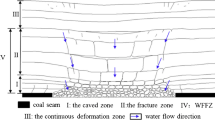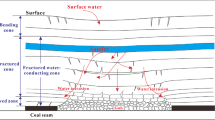Abstract
The burial depth and dip angle of a coal seam, the size of the working face, mining height, structure of the overlying strata, coal mining method, and the number of mining slices all significantly affect the amount of water flowing in a fractured zone. Combined with these seven factors, a predictive model for the height of water flowing in a fractured zone was established based on a fuzzy neural network, and 49 typical cases were chosen to train and test the network. The test error of the network was small and the match degree was high. Furthermore, the predicted height of water flowing in a fractured zone of working face 2309 in the Guozhuang coal mine, China was found to be within the range of the results calculated by more traditional (the empirical formula, the key stratum, and numerical simulation) predictive methods. After a safety coefficient of 1.2–1.5 was incorporated, a 183–211 m thick coal/rock safety pillar was required. In addition, a 98 m rock pillar with original permeability was left between the protective layer and the weathered zone. Therefore, under normal conditions, the mining of working face 2309 beneath Jianghe River was assessed to be safe and feasible.
Zusammenfassung
Die Lagerungstiefe und der Neigungswinkel eines Kohleflözes, die Größe der Arbeitsfläche, die Höhe des Abbaus, die Struktur der darüber liegenden Schichten, die Kohleabbaumethode und die Anzahl der Abbauabschnitte beeinflussen maßgeblich die Menge an Wasser, die in einer Bruchzone fließt. Zusammen mit diesen sieben Faktoren wurde ein Vorhersagemodell für die Höhe des in einer Bruchzone fließenden Wassers auf der Basis eines Fuzzy-Logik Neuronalen Netzes erstellt, und 49 typische Fälle wurden ausgewählt, um das Netzmodell zu trainieren und zu testen. Der Testfehler des Netzmodells war gering und der Übereinstimmungsgrad hoch. Darüber hinaus wurde festgestellt, dass die vorhergesagte Wasserhöhe in einer Bruchzone der Abbaufläche 2309 in der Guozhuang Kohlenmine in China im Bereich der Ergebnisse traditioneller Prognoseverfahren (wie empirische Formel, Schlüsselschicht und numerische Simulation) liegt. Nachdem ein Sicherheitsfaktor von ca. 1,2 - 1,5 eingebaut worden war, wurde ein etwa 183 - 211 m mächtiger Kohle/Stein-Sicherheitspfeiler benötigt. Zusätzlich wurde zwischen der Schutzschicht und der Verwitterungszone ein 98 m mächtiger Felspfeiler mit ursprünglicher Durchlässigkeit belassen. Deshalb wurde unter gewöhnlichen Bedingungen der Abbau der Arbeitsfläche 2309 unterhalb des Jianghe-Flusses als sicher und machbar bewertet
Resumen
La profundidad de enterramiento y el ángulo de inmersión de una veta de carbón, el tamaño de la superficie de trabajo, la altura de la mina, la estructura de los estratos por encima de la veta, el método de extracción de carbón y el número de cortes mineros afectan significativamente la cantidad de agua que fluye en una zona fracturada. Se construyó un modelo predictivo para la altura del agua que fluye en una zona fracturada combinando los factores anteriores y con base en una red neuronal difusa; se seleccionaron 49 casos típicos para entrenar y probar la red. El error de prueba de la red fue pequeño y el grado de coincidencia fue alto. Además, la altura predicha para el agua que fluye en una zona fracturada de la cara de trabajo 2309 en la mina de carbón de Guozhuang, China, se encontró dentro del rango de los resultados calculados por métodos más tradicionales (la fórmula empírica, el estrato clave y la simulación numérica). Después de incorporar un coeficiente de seguridad de 1,2 ~ 1,5, se requirió un pilar de seguridad de carbón/roca de 183 ~ 211 m de espesor. Además, se dejó un pilar de roca de 98 m con la permeabilidad original entre la capa protectora y la zona extraída. Esto permite que, en condiciones normales, la extracción de la cara de trabajo 2309 debajo del río Jianghe sea considerada segura y factible.
摘要
煤层埋深与倾角、工作面尺寸、煤层采高、覆岩结构、采煤方法和回采分层数显著影响导水裂隙带内水流量大小。综合上述七个因素, 建立了基于模糊神经网络的裂隙带水流高度预测模型, 利用49个典型案例训练并检验了预测模型。模型误差小、匹配程度高。据此预测郭庄矿(中国)2309工作面导水裂隙带高度在多种传统预测(经验计算、关键层方法和数值模拟法)范围之内。考虑1.2~1.5倍安全系数之后,工作面回采需要留设183~211 m厚煤岩柱。另外,保护层和风化层之间保留98m厚岩柱。在正常条件下,2309工作面在绛河下开采安全、可行。









Similar content being viewed by others
References
Beijing Mining Research Institute (1981) The law of surface movement and overlying strata failure of coal mine and its application. China Coal Science Research Institute, China Coal Industry Press, Beijing, pp 136–164 (in Chinese)
Chen RH, Bai HB, Feng MM (2006) Determination of the height of water flowing in a fractured zone in overburden strata above fully-mechanized top-coal caving face. J Min Saf Eng 23(2):220–223 (in Chinese)
Chen LJ, Li TF, Wang G, Wu XX, Jiang YJ, Han ZZ (2014) Study on crack expansion judgment method in overlying strata and its application for coal mining under aquifers. J Chin Coal Soc 39(S2):301–307 (in Chinese)
Deng JN, Peng XF (2015) Study on the feasibility of top-coal caving face mining under the water in Guozhuang coal mine. Shandong Coal Sci Technol 9:135–137 (in Chinese)
Dong DL, Lin G, Lin YFF, Zhao MD, Li K (2016) Evaluating induced fractures between a large artificial lake and an aquifer-coal seam system: a case study in Tangshan coal mine, China. Mine Water Environ 35(2):253–260
Du F, Gao R (2017) Development patterns of fractured water-conducting zones in longwall mining of thick coal seams—a case study on safe mining under the Zhuozhang river. Energies 10(11):1856
Fan ZL (2013) Mining safety research of thick coal seam under aquifers and surface water in Nalinhe mine area. China University of Mining and Technology, Beijing, pp 123–140 (in Chinese)
Gan SQ, Liu HP, Shen ZJ (2005) An improved T–S fuzzy neural network. Control Eng Chin 12(5):442–445 (in Chinese)
Gao BL, Liu YP, Pan JY, Yuan T (2014) Detection and analysis of height of water flowing fractured zone in underwater mining. Chin J Rock Mech Eng 33(S1):3384–3390 (in Chinese)
Jiang CY (2005) Research on fuzzy neural network model and its application. Nanjing Normal University, Nanjing, pp 5–10 (in Chinese)
Jiang JL, Gong YA (2010) Technology analysis and waterproofing measures for the mining under the river. Safe and efficient mine construction and mining technology. In: Proceedings, academic annual conference of shanxi coal society, pp 291–294 (in Chinese)
Li YQ (2007) Study on the prediction method of water-flowing fractured zone’s height and its application. Xi’an Univ of Science and Technology, Xi’an, pp 5–17+29 (in Chinese)
Li SY (2010a) Study on waterproofing technology of mining under Xiaolangdi reservoir in Xin’an coalfield. China University of Geoscience, Wuhan, pp 45–59 (in Chinese)
Li ZH (2010b) Research on failure mechanism and application of surrounding rock about thin bedrock coal seam with threat of water inrush. China University of Mining and Technology, Beinjing, pp 91–108 (in Chinese)
Li CW, Wang R, He ZZ, Liu ZJ (2011) Experimental study on water conducted fissure height under rivers in Gaotouyao coal mine. Saf Coal Min 42(03):12–15 (in Chinese)
Li DY, Ren Y, Jiang M, Ma ZH (2012) Height analysis for water-flowing fracture zone developed in overlying strata. Min Metall Eng 32(5):15–18 (in Chinese)
Liu JJ, Chen X, Zhang ZB, Zhang HQ (2005) Research on controlling methods of water resource running off in mining areas based on RFPA2D. Chin J Geol Hazard Control 3:130–133+137 (in Chinese)
Luan YZ, Li JT, Ban XH, Sang CY, Zhang CQ, Ma DP (2010) Observational research on the height of water flowing in a fractured zone in repeated mining of short-distance coal seams. J Min Saf Eng 27(1):139–142 (in Chinese)
Ma YJ, Wu Q, Zhang ZY, Hong YQ, Guo LW, Tian HS, Zhang LG (2008) Research on prediction of water conducted fissure height in roof of coal mining seam. Coal Sci Technol 36(5):59–62 (in Chinese)
Macfarlane NA, Adetuyibi A, Mills IH, (Wang LG) (2007) Water-burst mechanism and prevention measurement of II 6424 mining face in Liuqiao1st Colliery. Coal Min Technol 58(5):306–313 (in Chinese)
Mao Y, Shi L (2009) Practice and research of Qiutian Ditch underwater mining. Coal 18(7):7+17 (in Chinese)
Shi F, Wang XC, Yu L, Li Y (2010) 30 cases analysis of matlab neural network. Beihang University Press, Beijing, pp 218–228 (in Chinese)
Shi LQ, Xin HQ, Zhai PH, Li SC, Liu TB, Yan Y, Wei WX (2012) Calculating the height of water flowing fracture zone in deep mining. J Chin Univ Min Technol 41(1):37–41 (in Chinese)
State Bureau of Coal Industry (2000) The rules for pillar setting and coal mining about buildings, water body, railway and main shaft and lane. China Coal Industry Press, Beijing, pp 227–233 (in Chinese)
Sun YF, Yan YF, Zhang BZ, Liu SB (2013) Fuzzy neural network method based on the T–S model for the urban water demand forecasting and application. J Saf Environ 13(2):136–139 (in Chinese)
Takagi T, Sugeno M (1985) Fuzzy identification of systems and its applications to modeling and control. IEEE Trans Syst Man Cybern 15(1):116–132
Tang CA, Wang SH, Fu YF (2003) Numerical test of rock failure. Science Press, Beijing, pp 48–60 (in Chinese)
Wang D, Duan K, Li Q (2011) Forming mechanism of water crack zone by singleness sub-level caving mining. J Water Resour Water Eng 22(3):63–67 (in Chinese)
Wei JX, Chen YF (2010) Feasibility analysis of fully mechanized caving mining under the water body in Gaohe coal mine. Saf Coal Mines 41(6):117–119 (in Chinese)
Xu YC, Li ZH, Jia AL, Ding XP, Xu GM (2010) Site measurement and analysis on failure height of overburden strata under thick loose alluvium and thin bedrock. Coal Sci Technol 38(7):21–23 (in Chinese)
Xu JL, Zhu WB, Wang XZ (2012) New method to predict the height of fractured water-conducting zone by location of key strata. J Chin Coal Soc 37(5):762–769 (in Chinese)
Zhang PP (2015) Safety impact assessment of coal mining under daping mine reservoir. China Univ of Geoscience, Beijing, pp 40–49 (in Chinese)
Zhang Y, Lu WX, Chen SM, Gong L (2012) Groundwater quality evaluation based on TSFNN. Water Sav Irrig 7:35–38 (in Chinese)
Zhou ZS (2007) The application of fuzzy neural network based on T–S model in water quality evaluation. Hohai University, Nanjing, pp 4–20+41–49 (in Chinese)
Acknowledgements
This paper was supported by “Priority Academic Program Development of Jiangsu Higher Education Institutions,” and “the Fundamental Research Funds for the Central Universities (2017XKQY044)”. We thank LetPub (http://www.letpub.com) for its linguistic assistance during the preparation of this manuscript.
Author information
Authors and Affiliations
Corresponding author
Rights and permissions
About this article
Cite this article
Guo, H., Ji, M., Chen, K. et al. The Feasibility of Mining Under a Water Body Based on a Fuzzy Neural Network. Mine Water Environ 37, 703–712 (2018). https://doi.org/10.1007/s10230-018-0521-5
Received:
Accepted:
Published:
Issue Date:
DOI: https://doi.org/10.1007/s10230-018-0521-5




